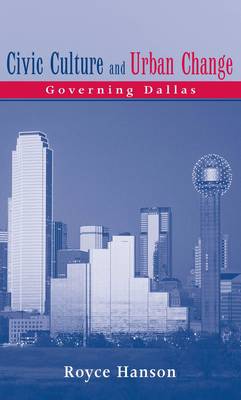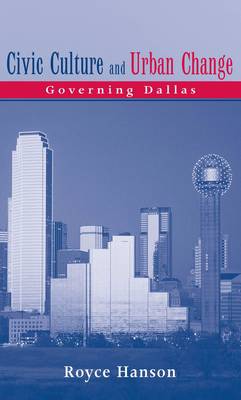
- Retrait gratuit dans votre magasin Club
- 7.000.000 titres dans notre catalogue
- Payer en toute sécurité
- Toujours un magasin près de chez vous
- Retrait gratuit dans votre magasin Club
- 7.000.000 titres dans notre catalogue
- Payer en toute sécurité
- Toujours un magasin près de chez vous
Description
A study of how civic culture shaped policy responses to the demographic and economic transformations of Dallas, Texas.
Civic Culture and Urban Change analyzes the Dallas government's adaptation to shifts in its demography and economic structure that occurred after the assassination of President John F. Kennedy in 1963. The book examines civic culture as a product of a governing regime and the constraints it placed on the capacity of the city to adapt to changes in its population, economy, and the distribution of political power. Royce Hanson traces the impact of civic culture in Dallas over the past forty years upon the city's handling of major crises in education, policing, and management of urban development and shows the reciprocal effect of those responses on the development of civic capital.
Hanson relates the city's civic culture to its economic history and political institutions by following the progression of Dallas governance from business oligarchy to regency of professional managers and federal judges. He studies the city's responses to school desegregation, police-minority conflicts, and other issues to illuminate the role civic and organizational cultures play in shaping political tactics and policy. Hanson builds a profile of political life in Dallas that highlights the city's low voter turnouts, sparse civic and political networks, and relative lack of multiracial institutions and mechanisms. Civic Culture and Urban Change summarizes the "solution sets" Dallas employs in dealing with major issues, and discusses the implications of those findings for the future of effective democracy in Dallas and other large cities.
Spécifications
Parties prenantes
- Auteur(s) :
- Editeur:
Contenu
- Nombre de pages :
- 480
- Langue:
- Anglais
Caractéristiques
- EAN:
- 9780814330807
- Date de parution :
- 01-04-03
- Format:
- Livre relié
- Format numérique:
- Genaaid
- Dimensions :
- 163 mm x 232 mm
- Poids :
- 898 g







